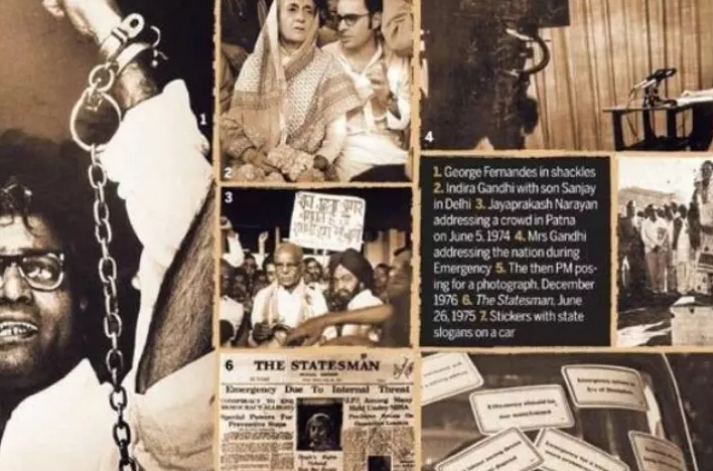1975 Emergency and its Impact (GS Paper 2, Polity)

Introduction
- The 1975 Emergency in India is a significant event in the country’s political history, marking a period of suspended civil liberties and heightened executive power.
- On June 25, 1975, Prime Minister Indira Gandhi declared a national emergency, citing internal disturbances.
- This period lasted until March 21, 1977, and had profound effects on the Indian polity, society, and constitutional framework.
- As we mark the 49th anniversary of this event, it is crucial to reflect on its causes, provisions, and lasting impacts.
What is an Emergency?
- An emergency refers to legal measures and clauses within a country's constitution or laws that enable the government to respond swiftly and effectively to extraordinary situations, such as war, rebellion, or other crises threatening the nation's stability, security, or sovereignty.
- In India, these provisions are outlined in Articles 352 to 360 under Part XVIII of the Constitution, drawing inspiration from Germany's Weimar Constitution.
Provisions in the Indian Constitution
The emergency provisions in the Indian Constitution include:
- Article 352: Proclamation of Emergency
- Article 353: Effect of Proclamation of Emergency
- Article 354: Application of provisions relating to the distribution of revenues while a Proclamation of Emergency is in operation
- Article 355: Duty of the Union to protect States against external aggression and internal disturbance
- Article 356: Provisions in case of failure of constitutional machinery in States
- Article 357: Exercise of legislative powers under proclamation issued under Article 356
- Article 358: Suspension of provisions of Article 19 during Emergencies
- Article 359: Suspension of the enforcement of the rights conferred by Part III during Emergencies
- Article 360: Provisions as to Financial Emergency
Types of Emergency in the Indian Constitution
National Emergency (Article 352)
- Under Article 352, the President can declare a state of emergency if the security of India or any part thereof is threatened by war, external aggression, or armed rebellion.
- The 44th Amendment replaced the term "internal disturbance" with "armed rebellion." The declaration allows the executive to suspend fundamental rights (except Articles 20 and 21) to address the crisis effectively.
Duration and Parliamentary Approval
- The emergency proclamation must be approved by both houses of Parliament within one month.
- If approved, it can continue for six months and be extended indefinitely with parliamentary approval every six months.
- A proclamation can be revoked by the President or by a resolution passed by the Lok Sabha.
State Emergency or President Rule (Article 356)
- Imposed in case of failure of constitutional machinery in a state, this type of emergency allows the President to assume the executive powers of the state government.
- Judicial review of such proclamations has been established by landmark cases like S.R. Bommai vs. Union of India (1994), ensuring that the imposition of President's Rule is based on relevant material and not extraneous grounds.
Financial Emergency (Article 360)
- A financial emergency can be declared if the President is satisfied that the financial stability or credit of India is threatened.
- During this emergency, the President can direct the reduction of salaries and allowances of all or any class of persons serving in the state and central governments, including judges of the Supreme Court and High Courts.
Impacts of the 1975 National Emergency
Constitutional Changes
The Emergency led to several constitutional amendments:
- 39th Amendment (1975): Placed disputes involving the President, Vice President, Prime Minister, and Speaker beyond the judiciary's scope.
- 42nd Amendment (1976): Increased central government control, limited judicial review, and extended the terms of Parliament and state assemblies.
- 44th Amendment (1978): Reversed the 42nd Amendment's changes, restoring judicial review and protecting the right to life and liberty under Article 21 even during emergencies.
Social and Political Impacts
- Erosion of Democratic Values: The Emergency period highlighted the fragility of democratic institutions. The suspension of civil liberties and the use of draconian laws like the Maintenance of Internal Security Act (MISA) led to widespread oppression.
- Grassroots Movements: The control over media and suppression of dissent led to the emergence of grassroots movements and underground press advocating for human rights. Notable examples include the Navnirman Andolan in Gujarat and the Jayaprakash Narayan Movement in Bihar.
- Judicial Activism: The judiciary's role fluctuated during the Emergency. While the ADM Jabalpur case (1976) upheld the suspension of fundamental rights, subsequent cases like Maneka Gandhi v. Union of India (1978) re-established the primacy of fundamental rights.
Changes in Political Parties' Attitude
- The Emergency united opposition parties, emphasizing the importance of a strong opposition in a democracy.
- Political parties became more cautious about resorting to similar measures in the future, reinforcing democratic processes.
Conclusion
- The 1975 Emergency serves as a crucial reminder of the importance of democratic values and the need for checks and balances in governance.
- The constitutional provisions and subsequent amendments highlight the resilience of India’s democratic framework, ensuring that emergency powers are not misused.
- As we reflect on this period, it is essential to continue safeguarding democracy, upholding the rule of law, and protecting individual rights, even in times of crisis.


